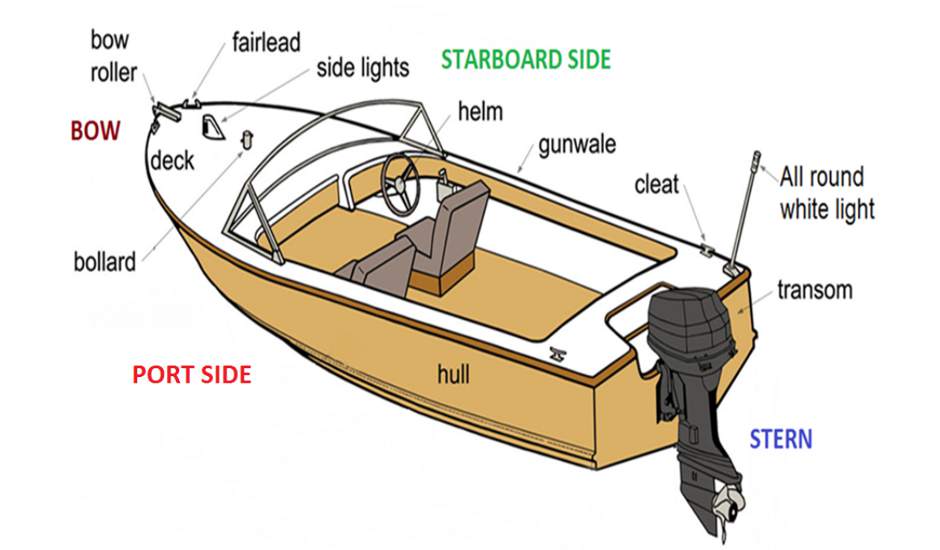

On sailboats, it is usually in the back and it is an open area without a roof, though this varies. The cockpit is the area where a boat is operated from. It is there mainly for stability and to help maintain forward direction when sailing. The sizes and shapes vary, sometimes it is relatively short and goes deep, (fin keel) sometimes it runs from the front all the way to the back (full keel or ballast keel). The keel is an underwater fin below the boat's belly. Structures sitting on top of the deck, like a deck salon or cabins, aren't considered a part of the hull anymore. Whatever the shape or size, whether opened on top (like a dinghy) or closed by a deck, (like a traditional sailboat) it's all called a hull. By the way, since aerodynamics and hydrodynamics work in similar ways, a plane is also operated by a rudder. Connected to a tiller or a helm, it is used to control the direction of your exciting voyage. The rudder is the long, flat piece of metal or wood that sits underwater below the back of your boat. Or by people who prefer it to a helm, since a tiller offers a bit more in terms of response. It has the same function as a helm does, but it is usually used on smaller boats, where a helm would take up too much space. Tiller is the long stick that operates your boat's rudder. Though I doubt linguistic economy was the reason. In this case, I forgive those who came up with this name, since it is shorter than 'steering wheel' and thus saves valuable time that we can spend on sailing. You want to know these because unlike the direction terms where you can do with 'left' and 'right', you don't want to call a tiller 'that stick thing back there'. Since there are gadgets and parts on the boat that you won't see anywhere else, it only makes sense they all have their own special name. Thus even if the wind was coming 20 degrees right off of the direction of the boat, so almost from the front, left would still be considered the leeward side. Note that neither windward nor leeward specify the angle of the wind. If the wind is coming from the right side, the leeward side is on the left. Leeward side of the boat is the lee side. Unlike some of the previous ones, this term actually makes sense - at times you need to talk about a direction not fixed in relation to the boat, but rather relative to the direction of the wind. So if the wind is coming from the right side, the windward side is on the right. The windward side of the boat is the side facing into the wind. Whether you will force your crew to call it 'stern' or let them use the word 'back', like the dry land creatures they are, is up to you. That is where you, as a captain, will spend most of your time. But it won't get you the admiring looks from those around you. If you call it 'front' instead, you will get your message across just as well. The word likely comes from the Middle Dutch 'boech' (nowadays spelled 'boeg'). Alright, let's keep calling it starboard. Oh, wait… you wouldn't seem as cool if you did. Again, you might as well just call it 'right'.

If in a car, you say 'look to your right', on a boat, you say 'look to the starboard'. The name came to existence because centuries ago, you always docked your big boat with the harbor (port) being on the left side. I'm not entirely sure why don't they just call it 'left' these days.

because it isn't as easy as 'left', 'right', 'front' and 'back'. Here are the only 50 sailing terms you'll need to know: If you are looking for a specific term, just ctrl+f your way directly to it. For the sake of good manners, I have categorized them by topic. I've also added pictures so you'll know what we're talking about. So in this article, I've filtered out the most important ones to get you up to speed quickly. There are a lot of obscure words listed that no one really uses anyways. But no one in his or her right mind will read through that entire page (it has 48.434 words!). For a comprehensive list, check out this Wikipedia glossary of nautical terms. This is a great resource for beginning sailors that need an overview of the most important sailing terms without drowning in it. In this article, I'll go over the most important sailing terms for beginners. Ever get confused by all those odd sailing terms? Starboard, tack, jib… Well, no worries.


 0 kommentar(er)
0 kommentar(er)
